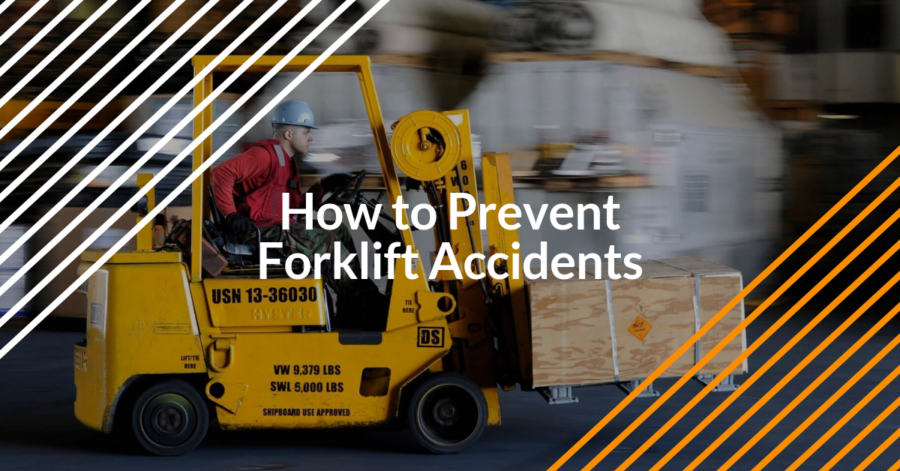How to Prevent Forklift Accidents

Forklifts are the real workhorses in warehouse work site. Without them, the process of moving materials and products to where they need to be would take longer and be less efficient. The only downside is that forklifts are dangerous machines.
Forklifts only account for about 1% of all warehouse or factory accidents. Yet, they produce 10% of the injuries at those work sites. Each year, forklift accidents:
- Cause about 85 deaths
- Seriously injure nearly 35,000 workers
- Can more than 61,000 minor injuries
Tipovers account for 24% of all forklift accidents. Other leading causes include overloading the forks, unbalanced loads, driving too fast, not watching out for pedestrians, and poor maintenance.
OSHA estimates up to 70% of forklift accidents in the U.S. could be prevented. But only with more focus on training and certification. In a moment we will discuss how to prevent forklift accidents. But first let’s look at what makes them so dangerous.
Why Are Forklifts So Risky?
At first glance, forklifts look fairly safe to operate. They’re solid, sturdy machines. They can’t go very fast. They have a low center of gravity. And workers have to be certified to operate them. Yet, a number of factors make forklifts risky to operate.
For starters, they can weigh up to 9,000 pounds. That’s three times heavier than the average car. With that much weight, you don’t have to go very fast to cause serious damage to people or equipment. Forklifts only have brakes in the front, which makes them harder to stop. Uneven weight distribution when carrying loads can make them hard to handle. Carrying the load in front can restrict the driver’s line of vision. And lifting heavy loads 10 to 15 feet or higher always entails a certain amount risk.
Work site factors can also cause forklift accidents. Wet, slippery floors can cause forklifts to lose traction. Tight, narrow aisles make it hard to maneuver. They often require sharp, sudden turns that can lead to tipovers. When paths aren’t clearly marked, pedestrians can wander into the path of a forklift.
Six Types of Forklift Accidents
Forklift accidents generally fall into one of six categories:
Organizational factors. With these types of forklift accidents, employers shoulder the blame. They may fail to keep the trucks properly maintained. Managers may set unrealistic timelines and goals, that force workers to cut corners. They may not provide proper training to all forklift workers. Or they can assign an operator to a forklift he isn’t trained on.
Employee factors. It should come as no surprise that forklift operators cause a large percentage of the accidents. These can result from:
- Driving too fast
- Using unsafe loading and lifting techniques
- Poor balancing of loads on the forks
- Being in a hurry to finish the shift
- Violating company safety guidelines
Workplace design. Some work sites make it hard to drive safely. Narrow, crowded aisles, disorganized loading docks, blocked entryways and exits, poor lighting, and more. These types of design problems are a management issue. But employees need to report them so managers can take action to fix them.
Load characteristics. Over-weight and over-sized loads are accidents waiting to happen. Failure to properly balance the load on the fork is another. Operators should know the top weight limits as well as proper balancing techniques. This is another training issue. A properly trained operator knows how to:
- Correctly stack or place objects on the pallet
- Make sure the load is not too heavy
- Make sure the load is stable
- Make sure the load will not block his vision
Mechanical factors. These are mostly equipment malfunctions: brakes, steering, clutch, linkage, mast assembly or transmission. They also include emissions, blind spots, items that block the operator’s view, and safety devices that don’t work right. Making sure equipment is maintained is the duty of the employer. But trained operators will know when mechanical factors are unsafe and will refuse to work until they are fixed.
Accidents with pedestrians. These may be avoided by separating pedestrian traffic from vehicle traffic. This can be done with designated travel ways or walkways. Training staff on how to communicate with one another and wearing high-visibility gear can also help prevent pedestrian accidents.
Forklift Accident Prevention
Now that we know what causes them, here’s how to prevent forklift accidents.
- Have clear safety guidelines. Keep the trucks properly maintained. Give workers adequate time to get the job done.
- Follow all safety guidelines. Stick within speed limits. Use safe loading and lifting techniques. Stay alert to pedestrians and hazards.
- Workplace design. Remove all hazards that can be removed. Post signs or warning tape on those that can’t. Avoid narrow aisles and sharp turns. Keep the warehouse clean and organized. Make doors and exits wide enough for the forklifts.
- Load characteristics. Make sure operators know the weight limit for their truck. Make sure loads are properly balanced on the forks.
- Always inspect the forklift before starting a shift. Perform truck maintenance on schedule. Workers should report any safety problems as soon as they notice them.
Training Saves Lives
The common thread in how to prevent forklift accidents is adequate training and certification. There are many good reasons for forklift training. First, OSHA requires that all operators be certified. You risk costly fines if an accident occurs and the operator isn’t certified. Trained workers are more productive and efficient. They take better care of the equipment. And, most important, training reduces accidents and saves lives.
ForkliftCertification.com has been training and certifying forklift drivers since 2002. Call us today at 888-278-8896.